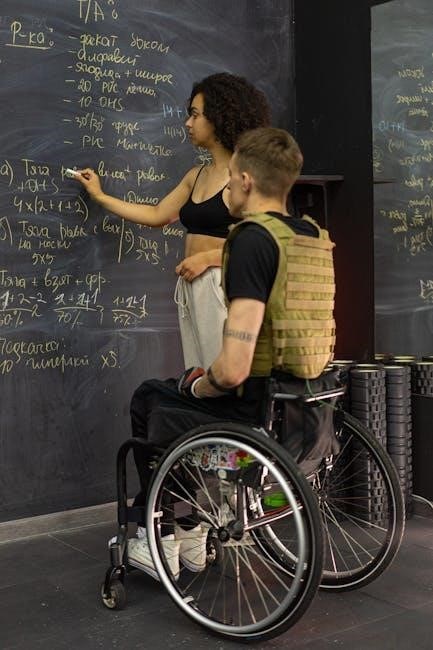
An instructional assistant, also known as a teacher aide or educational assistant, plays a vital role in supporting teachers and students in educational settings. They assist with lesson preparation, student supervision, and individualized support, ensuring a productive learning environment. This role is essential for enhancing student outcomes and easing the workload of teachers, making it a cornerstone of modern education systems.
Definition and Overview
An instructional assistant, often referred to as a teacher aide or educational assistant, is an essential support staff member in educational settings. Their primary role involves assisting teachers in delivering instruction, managing classroom activities, and providing direct support to students. Instructional assistants help with lesson preparation, supervise students during activities, and assist with administrative tasks. They work closely with teachers to create an effective learning environment, ensuring students receive the guidance they need. This role is critical in enhancing student engagement, academic performance, and overall educational outcomes, making instructional assistants invaluable to schools and educators alike.
Importance in Educational Settings
Instructional assistants are crucial in educational settings as they provide essential support to both teachers and students. By managing administrative tasks, preparing materials, and assisting with lessons, they enable teachers to focus more on instruction. They also offer personalized attention to students, helping them understand complex concepts and complete assignments. Additionally, instructional assistants foster a positive classroom environment by promoting student engagement and addressing diverse learning needs. Their contributions enhance the overall quality of education, making them indispensable to effective teaching and learning processes in schools.
Evolution of the Role
The role of instructional assistants has evolved significantly over time, transitioning from basic support tasks to more specialized responsibilities. Historically, their primary focus was on clerical duties and student supervision. However, as education systems advanced, the role expanded to include direct student support, such as assisting with learning activities and monitoring progress. Modern instructional assistants now often specialize in areas like technology integration, special education, and bilingual support. This evolution reflects the growing recognition of their critical role in fostering student success and adapting to diverse educational needs in contemporary classrooms.

Roles and Responsibilities
Instructional assistants support teachers, assist students, prepare materials, and manage administrative tasks, ensuring a smooth and effective learning environment that fosters academic success and student engagement.

Supporting Teachers in the Classroom
Instructional assistants play a crucial role in supporting teachers by preparing educational materials, organizing classroom resources, and assisting with lesson delivery. They help manage classroom behavior, supervise group activities, and provide individualized support to students as needed. By handling administrative tasks such as grading papers and maintaining records, instructional assistants allow teachers to focus on instruction and student development. Their support ensures a well-organized and efficient learning environment, enabling teachers to deliver high-quality education effectively. This collaborative partnership enhances both teaching and learning outcomes, benefiting students and educators alike in the educational process.
Assisting Students with Learning Activities
Instructional assistants work closely with students to facilitate their understanding and participation in learning activities. They provide individualized support, helping students complete assignments, and reinforcing concepts taught by teachers. By guiding students during group work and independent tasks, instructional assistants ensure that learners stay engaged and on track. They also assist with hands-on activities, such as experiments or art projects, and use visual aids or technology to enhance comprehension. This direct student support enables instructional assistants to address diverse learning needs, fostering academic growth and confidence in students of all abilities and backgrounds.
Preparing Educational Materials
Instructional assistants are responsible for preparing and organizing educational materials to support lesson plans. This includes creating handouts, assembling worksheets, and arranging visual aids like charts or posters. They also set up classrooms, ensuring all necessary supplies are available and accessible. Additionally, they may prepare digital materials, such as slides or online resources, to enhance teaching effectiveness. By efficiently organizing and distributing materials, instructional assistants enable teachers to focus on instruction and ensure students have the tools they need for successful learning experiences.
Monitoring Student Progress
Instructional assistants play a key role in monitoring student progress, ensuring each learner meets educational goals. They observe students during activities, track completion of assignments, and identify areas where additional support may be needed. By documenting progress and sharing insights with teachers, they help tailor instruction to individual needs. This collaborative approach enables personalized learning strategies, fostering academic growth and addressing challenges promptly. Their efforts contribute significantly to creating a supportive and effective learning environment for all students.
Communicating with Parents and Guardians
Instructional assistants often serve as a vital link between teachers and parents, ensuring effective communication. They may share updates on student progress, behavior, and specific needs, fostering collaboration. By maintaining open lines of communication through emails, meetings, or reports, assistants help parents stay informed and involved in their child’s education. This role is crucial for building trust and ensuring a united approach to supporting students’ academic and personal development. Clear and consistent communication helps create a cohesive educational environment, benefiting both students and their families.

Educational Requirements
Instructional assistants usually require a high school diploma, with some roles needing an associate degree or educational certification. Background checks and relevant training are often necessary.
Typical Qualifications and Certifications
Instructional assistants typically require a high school diploma, though some roles may demand an associate degree or specialized certifications. Many employers prefer candidates with training in education or child development. Certifications like CPI (Crisis Prevention Institute) or first aid/CPR are often required. Additionally, background checks and fingerprinting are standard for working in schools. Some states or schools may require instructional assistants to complete specific coursework or pass a competency exam. These qualifications ensure that assistants are well-prepared to support teachers and students effectively in educational environments.
Continuing Education and Professional Development
Instructional assistants often engage in continuing education to enhance their skills and stay updated on educational practices. Workshops, seminars, and online courses are common methods for professional development. Many employers require assistants to complete a certain number of training hours annually. Topics may include classroom management, technology integration, and special education strategies. Some assistants pursue certifications in areas like Paraeducator or Educational Assistant to advance their careers. Continuous learning ensures they remain effective in supporting teachers and meeting the diverse needs of students in evolving educational environments.
Skills and Qualifications
Instructional assistants need strong communication, patience, and organizational skills. They often require basic computer skills and knowledge of educational software to support teaching effectively.
Essential Hard Skills
Instructional assistants require proficiency in educational software and tools to support teaching. Strong data entry and record-keeping skills are crucial for tracking student progress. Familiarity with MS Office and Google Classroom is essential for preparing materials. Basic technical skills for online learning platforms are increasingly important. Knowledge of curriculum standards and lesson planning tools enhances their ability to assist teachers effectively. These hard skills ensure instructional assistants can efficiently manage tasks, support learning activities, and maintain organization in the classroom or virtual environment.
Necessary Soft Skills
Instructional assistants must possess strong interpersonal skills to communicate effectively with students, teachers, and parents. Patience and understanding are crucial when working with diverse learners. Empathy allows them to support students with emotional or academic challenges. Flexibility and adaptability are essential for managing varied tasks and unexpected situations. Good organizational and time management skills ensure efficient support in the classroom. Strong problem-solving abilities help address student needs and classroom challenges. A positive attitude fosters a supportive learning environment, while teamwork enhances collaboration with educators. These soft skills are vital for creating a productive and inclusive educational setting.

Work Environments
Instructional assistants work in schools, colleges, and educational institutions, supporting learning in traditional classrooms, special education settings, and virtual environments, adapting to diverse educational needs and spaces.
Elementary, Middle, and High Schools
Instructional assistants play a vital role in elementary, middle, and high schools, supporting teachers and students across various grade levels. They assist with lesson preparation, supervision, and individualized student support. In elementary settings, they often focus on foundational skills, while in middle and high schools, they may help with more complex subjects. These professionals adapt their strategies to meet the developmental needs of students, fostering a collaborative and inclusive learning environment. Their contributions are essential for ensuring students receive the guidance and resources they need to succeed academically and socially.
Special Education Settings
In special education settings, instructional assistants provide targeted support to students with diverse learning needs. They work closely with special education teachers to implement Individualized Education Programs (IEPs), assisting with tailored instruction and therapies. Duties may include adapting materials, providing one-on-one support, and helping with daily living skills. These professionals often work with students who have physical, emotional, or developmental disabilities, ensuring their access to a meaningful education. Their role is critical in fostering an inclusive and supportive learning environment that addresses each student’s unique challenges and goals.
Post-Secondary Institutions
In post-secondary institutions, instructional assistants support faculty and students in higher education settings. They often work in lecture halls, labs, or study groups, assisting professors with demonstrations and discussions. Duties may include preparing materials, managing resources, and facilitating small group activities. They also provide individualized support to students, helping with assignments or research. Their role bridges the gap between faculty and students, ensuring a smooth learning experience. Instructional assistants in these settings often need strong organizational and technical skills to adapt to the institution’s academic demands and evolving student needs.
Online and Virtual Learning Environments
In online and virtual learning environments, instructional assistants play a crucial role in supporting both instructors and students. They often manage digital platforms, assist with technical issues, and monitor student engagement. Responsibilities include facilitating online discussions, grading assignments, and providing individualized support through virtual meetings. Instructional assistants also help create and organize digital materials, ensuring accessibility for all learners. Their adaptability and technical proficiency are essential in maintaining the flow of virtual classrooms and fostering an effective learning experience in remote settings.

Difference from Teachers
Instructional assistants support teachers and students, focusing on specific tasks, while teachers lead instruction, develop curricula, and assess student performance, holding primary responsibility for learning outcomes.
Scope of Responsibilities
Instructional assistants work under teacher supervision, supporting classroom activities, assisting students, and managing materials. Their role includes helping with lesson preparation, monitoring student behavior, and providing individualized support. They may also assist with administrative tasks, such as grading or organizing records. While they play a crucial role in education, their responsibilities are more focused and less independent compared to teachers, who are responsible for curriculum development and overall instructional leadership. The scope of their duties is designed to enhance the learning environment while supporting both students and educators effectively.
Authority and Decision-Making
Instructional assistants have limited authority and decision-making power, as they operate under the supervision of teachers or school administrators. Their role typically does not involve major decision-making regarding curriculum, instructional strategies, or student assessments. While they may make minor decisions about how to support students or organize materials, their authority is constrained by their supportive role. Ultimate responsibility for educational decisions rests with teachers, who oversee lesson plans and student evaluations. This hierarchy ensures clear lines of authority in the educational environment.

Professional Development
Professional development for instructional assistants includes ongoing education and training to enhance their skills and adapt to new teaching methods and technologies.
Opportunities for Career Advancement
Instructional assistants can advance their careers by gaining experience and pursuing additional certifications or degrees. Many transition into lead assistant roles or specialize in areas like special education. Some pursue teaching credentials, while others move into administrative or curriculum development positions. Continuous professional development, such as attending workshops or earning advanced certifications, enhances career prospects. Networking and mentorship opportunities also play a key role in advancing within the field. With dedication and further education, instructional assistants can expand their roles and contribute more significantly to educational settings.

Importance of Ongoing Training
Ongoing training is crucial for instructional assistants to stay updated on educational trends, teaching strategies, and technologies. Continuous professional development ensures they can effectively support diverse student needs, including those with special requirements. Training also helps assistants adapt to curriculum changes and classroom management techniques. By staying informed, they enhance their ability to collaborate with teachers and contribute to a dynamic learning environment. Regular training fosters professionalism and equips assistants with the skills needed to address evolving challenges in education, ultimately benefiting both students and educators.

Benefits and Challenges
Benefits include fostering student growth, job variety, and personal development. Challenges involve emotional demands, high workloads, and limited career advancement opportunities.
Advantages of Being an Instructional Assistant
Being an instructional assistant offers numerous advantages. It provides the opportunity to make a positive impact on students’ lives and contribute to their educational journey. The role allows for direct interaction with students, fostering personal growth and satisfaction. Additionally, it offers a flexible and dynamic work environment, with varied tasks that keep the job engaging. It also serves as an excellent stepping stone for those aspiring to pursue teaching or educational leadership careers. The role is ideal for individuals passionate about education and eager to support both students and educators.
Challenges Faced in the Role
Instructional assistants often face challenges such as managing diverse student needs and behaviors. High student-to-assistant ratios can limit individualized support. Additionally, the role may involve emotional demands, as assistants work with students who have behavioral or learning difficulties. Communication barriers with parents or guardians can also arise, especially in multilingual settings. Lastly, the position may lack clear career advancement pathways, potentially leading to job satisfaction concerns over time. These challenges require patience, adaptability, and strong interpersonal skills to navigate effectively.
Salary Expectations
Instructional assistants typically earn modest salaries, with pay varying by location and employer. Average annual salaries range from $25,000 to $40,000, depending on experience and setting.
Average Salary Ranges
Average Salary Ranges
Instructional assistants typically earn between $25,000 and $40,000 annually, depending on location, employer, and experience. Urban areas often offer higher salaries, while rural regions may pay less. Entry-level positions may start around $20,000, while experienced assistants can earn up to $45,000 or more. Salaries also vary by institution type, with public schools generally offering higher pay than private schools. Part-time roles may provide lower compensation and fewer benefits. Overall, salaries reflect regional economic conditions and the budgetary constraints of employing institutions.
Factors Influencing Salary
The salary of instructional assistants is influenced by factors such as location, employer type, and level of experience. Urban schools and universities often pay more than rural or private institutions. Additionally, assistants with specialized certifications or higher education degrees may earn higher wages. Experience also plays a significant role, with seasoned professionals commanding better salaries. Institutional budgets and funding sources, such as public vs. private funding, further impact earnings. Regional cost of living and demand for educational support staff also shape salary levels.
Instructional assistants play a vital role in supporting teachers and students, contributing to effective learning environments and positively impacting educational outcomes.

Instructional assistants are essential educators who support teachers, students, and schools by assisting with lessons, materials, and student supervision. They work across various educational settings, from elementary to post-secondary institutions, and specialize in aiding students with diverse needs, including special education. Their roles involve preparing materials, monitoring progress, and fostering communication between teachers, students, and parents. While they typically hold certifications like associate degrees or specialized training, ongoing professional development is crucial. Their adaptability and dedication make them indispensable in creating inclusive and effective learning environments.
Future Outlook for Instructional Assistants
The demand for instructional assistants is expected to grow due to increasing student populations and a focus on personalized learning. Technological advancements will likely integrate more digital tools into their roles, enhancing efficiency. There will also be a greater emphasis on supporting diverse student needs, including multilingual and special education environments. As schools evolve, instructional assistants will play a key role in adapting to new teaching methods and educational technologies, ensuring they remain integral to modern education systems. Professional growth opportunities will continue to expand, meeting the changing demands of the educational landscape.